Description
ASTM A334 Gr.6 seamless steel tubes are low temperature carbon steel tubes that are used for transporting fluids at low temperatures.
ASTM A334 Seamless and Welded Carbon and Alloy-Steel Tubes for Low-Temperature Service.
ASTM A334 Gr.6 seamless steel tubes are suitable for use in boilers, pressure vessels, and heat exchangers. They are manufactured using high-quality carbon steel and are designed to withstand low temperatures and high pressure. These tubes have excellent dimensional accuracy and are available in different sizes and thicknesses to meet the specific requirements of different applications. ASTM A334 Gr.6 seamless steel tubes have good welding properties and can be welded easily without any distortion or cracking.
Note:
- Mill test certificates will be issued according to EN10204.3 3.1 or 3.2
Packing:
- Packed in wooden box or bundles protected with plastic paper, and suitably protected for sea-worthily delivery or as requested.
- The Product marking shall include the ASTM A334 or ASME SA334, Grade, size, heat no., Lot No. and Manufacture name or logo.
Scope
1.1 This specification2 covers several grades of minimum-wall-thickness, seamless and welded, carbon and alloy-steel tubes intended for use at low temperatures. Some product sizes may not be available under this specification because heavier wall thicknesses have an adverse affect on low-temperature impact properties.
1.2 Supplementary Requirement S1 of an optional nature is provided. This shall apply only when specified by the purchaser.
NOTE 1: For tubing smaller than 1/2 in. [12.7 mm] in outside diameter, the elongation values given for strip specimens in Table 1 shall apply. Mechanical property requirements do not apply to tubing smaller than 1/8 in. [3.2 mm] in outside diameter and with a wall thickness under 0.015 in. [0.4 mm].
1.3 The values stated in either inch-pound units or SI units are to be regarded separately as standard. Within the text, the SI units are shown in brackets. The values stated in each system are not exact equivalents; therefore, each system must be used independently of the other. Combining values from the two systems may result in nonconformance with the specification. The inch-pound units shall apply unless the “M” designation of this specification is specified in the order.
1.4 This standard does not purport to address all of the safety concerns, if any, associated with its use. It is the responsibility of the user of this standard to establish appropriate safety, health, and environmental practices and determine the applicability of regulatory limitations prior to use.
1.5 This international standard was developed in accordance with internationally recognized principles on standardization established in the Decision on Principles for the Development of International Standards, Guides and Recommendations issued by the World Trade Organization Technical Barriers to Trade (TBT) Committee.
What is ASTM ASTM A334 Gr.6 pipe equivalent to?
ASTM A333 Grade 6 pipe is equivalent to several international standards including EN/DIN 10216-2, BS 3059 Part 2, and ASME SA-106.
ASTM A334 Gr.6 Chemical Compositions
| Standard |
Grade |
Chemical Components (%) |
| C |
Si |
Mn |
P |
S |
Ni |
| ASTM A334/ ASME SA334 |
GR.6 |
≤0.30 |
≥0.10 |
0.29-1.06 |
≤0.025 |
≤0.025 |
/ |
Mechanical Tests Required
| Standard |
Grade |
Mechanical Properties |
| Tensile |
Yield |
Elongation |
The Low degree of Temperature test |
| Strength (Mpa) |
Strength (Mpa) |
(%) |
| ASTM A334/ ASME SA334 |
Gr.6 |
≥415 |
≥240 |
≥30 |
-45° |
Maximum Hardness Number
| Grade |
Rockwell |
Brinell |
| ASTM A334 Grade 6 |
B90 |
190 |
A334 GR.6 Impact requirements
| Size of Specimen, mm |
Minimum Average Notched Bar Impact Value of. Each Set of Three Specimens |
Minimum Notched Bar Impact Value of One Specimen Only of a Set |
| ft·lbf |
J |
ft·lbf |
J |
| 10 by 10 |
13 |
18 |
10 |
14 |
| 10 by 7.5 |
10 |
14 |
8 |
11 |
| 10 by 6.67 |
9 |
12 |
7 |
9 |
| 10 by 5 |
7 |
9 |
5 |
7 |
| 10 by 3.33 |
5 |
7 |
3 |
4 |
| 10 by 2.5 |
4 |
5 |
3 |
4 |
ASTM A334 Gr.6 Impact Temperature Reduction:
| Specimen Width Along Notch or Accrual Material Thickness |
Temperature Reduction, Degrees Colder |
| In. |
mm |
℉ |
℃ |
| 0.394 |
10(Standard size) |
0 |
0 |
| 0.354 |
9 |
0 |
0 |
| 0.315 |
8 |
0 |
0 |
| 0.295 |
7.5(3/4 std. size) |
5 |
3 |
| 0.276 |
7 |
8 |
4 |
| 0.262 |
6.67(2/3 std. sze) |
10 |
5 |
| 0.236 |
6 |
15 |
8 |
| 0.197 |
5(1/2 std. size) |
20 |
11 |
| 0.158 |
4 |
30 |
17 |
| 0.131 |
3.33(1/3 std. size) |
35 |
19 |
| 0.118 |
3 |
40 |
22 |
| 0.099 |
2.5(1/4 std. size) |
50 |
28 |
Other Mechanical tests as follows:
l Flattening Test One flattening test shall be made on specimens from each end of one finished tube of each lot.
l Flare Test (Seamless Tubes) One flare test shall be made on specimens from each end of one finished tube of each lot.
l Flange Test (Welded Tubes) One flange test shall be made on specimens from each end of one finished tube of each lot.
l Reverse Flattening Test For welded tubes, one re- verse flattening test shall be made on a specimen from each 1500 ft [460 m] of finished tubing.
l Hardness Test Brinell or Rockwell hardness tests shall be made on specimens from two tubes from each lot (Note 3).
l Impact Tests One notched-bar impact test, consisting of breaking three specimens, shall be made from each heat represented in a heat-treatment load on specimens taken from the finished tube.
ASTM A334 / ASME SA334 GR.6 tubes Hydrostatic or NDT test
Each A334 GR.6 tube shall be subjected to the nondestructive electric test or the hydrostatic test. The type of test to be used shall be at the option of the manufacturer, unless otherwise specified in the purchase order.
Heat Treatment
All A334 GR.6 seamless and welded tubes, other than Grades 8 and 11, shall be treated to control their microstructure in Accor- dance with one of the following methods:
- Normalize by heating to a uniform temperature of not less than 1550°F [845°C] and cool in air or in the cooling chamber of an atmosphere-controlled furnace.
- Normalize as in standard 10.1.1, and, at the discretion of the manufacturer, reheat to a suitable tempering temperature.
- For the seamless process only, reheat and control hot working and the temperature of the hot-finishing operation to a finishing temperature range from 1550 to 1750°F [845 to 955°C] and cool in a controlled atmosphere furnace from an initial temperature of not less than 1550°F [845°C].
- Treat as in 6.1.3 and, at the discretion of the manufacturer, reheat to a suitable tempering temperature.
Referenced Documents
- A 370 Test Methods and Definitions for Mechanical Testing of Steel Products
- A 450/A450M Specification for General Requirements for Carbon, Ferritic Alloy, and Austenitic Alloy Steel Tubes3
- E 23 Test Methods for Notched Bar Impact Testing of Metallic Materials5
Ordering Information
ASTM ASME A/SA334 GR.6 Seamless Tubes Orders for material under this specification should include the following, as required, to describe the material adequately:
- Quantity (feet, centimeters, or number of lengths),
- Name of material (seamless or welded pipe),
- Grade
- Size (outside diameter and minimum wall thickness),
- Length (specific or random)
- Optional requirements, (other temperatures, Section 13; hydrostatic or electric test, Section 15),
- Test report required, (Certification Section of Specification A 450/A 450M),
- Specification designation,
- Special requirements and any supplementary requirements selected.
Process
Cold drawn seamless steel tube deformed process
Cold Drawn Seamless Mechanical Tubing (CDS) is a cold drawn 1018/1026 steel tube which offers uniform tolerances, enhanced machinability and increased strength and tolerances compared to hot-rolled products.
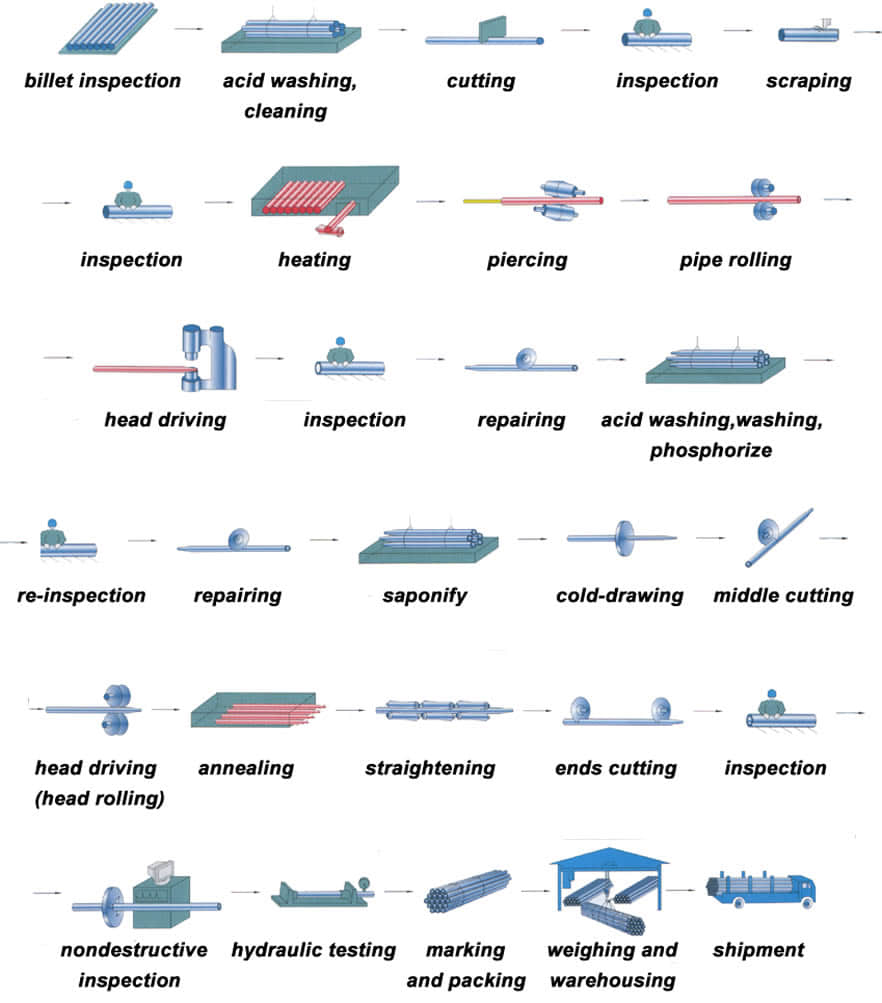
Cold drawn steel tube is with hot-rolled steel coil as raw material, and tandem cold rolling pickled to remove oxide scale, its finished rolling hard roll, rolling hard volumes due to the continuous cold deformation caused by cold hardening strength, hardness increased indicators declined tough plastic, stamping performance will deteriorate, which can only be used for simple deformation of the parts.
Rolling hard roll can be used as the raw material of the hot-dip galvanizing plant, hot dip galvanizing line set annealing line. Rolling hard roll weight is generally 6 to 13.5 tons, the coil diameter of 610mm.
Hot rolled seamless steel pipe deformed process
Hot-rolled seamless steel pipe production base deformation process can be summarized as three stages: perforation, extension and finishing.
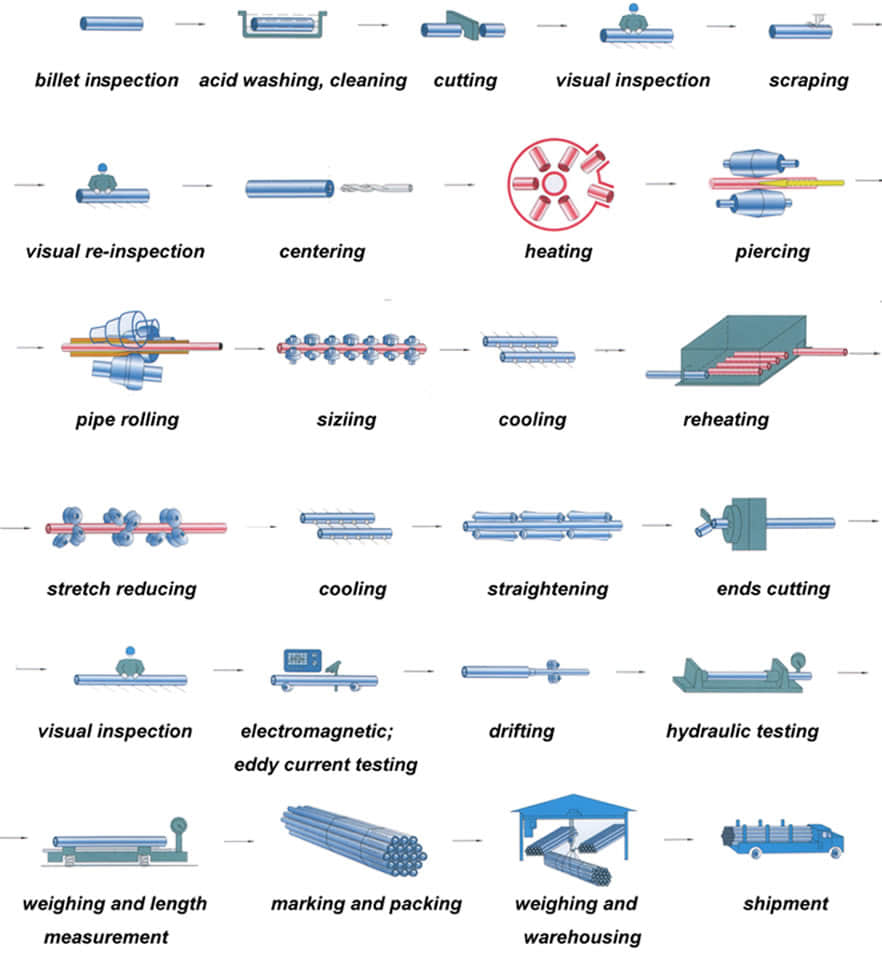
The main purpose of the perforation process is to become a solid round billet piercing hollow shell. Capillary in the specifications, accuracy and surface quality can not meet the requirements of the finished product, further improvements are needed to deform the metal through. The main purpose of the stretching machine is further reduced sectional view (main compression wall) for a larger axial extension, so that the capillary improved dimensional accuracy, surface quality and organizational performance.
After stretching machine rolled steel pipe shortage collectively need further molding mill in order to achieve the requirements of the finished pipe. Rolled steel due to pass in the method widely used in the production of seamless steel tubes.
So far, due to the method pass rolling steel can be divided into two categories: core pension without rolling rolling (hollow body rolling), and with the mandrel. Sizing machines, reducing mill and stretch reducing mill belonging to the hole without mandrel type continuous rolling mills are generally coffin. Its main purpose is to reduce the diameter of the deformation process or sizing get finished steel, the wall thickness of process control, can make thinning, thickening or nearly unchanged.
All the traditional hole-type rolling machine with mandrel belong to extend machine. The main purpose is to reduce the deformation process perforated capillary wall thickness and outer diameter roll passes in the deformation zone and the mandrel posed, for a larger axial extension. At the same time a certain improvement in the organization, performance, accuracy, surface quality.
Cut to Length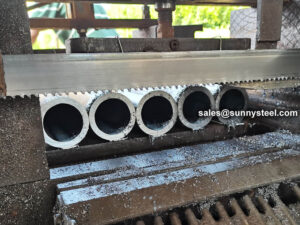
Before cutting pipe and tubing
No matter the material, measure the diameter of the pipe or tube to be cut to ensure that you use the right-size tube cutter for the job. When determining how to make a straight cut, use a tape measure and a pencil or other writing instrument to mark on the surface where you want to cut. If possible, mark around the circumference of a pipe, especially when cutting with a handsaw. Ensure that a cut is as straight as possible by securing the pipe with a vise, clamp, miter box or even duct tape to keep the length from shifting out of place while cutting.
After cutting pipe and tubing
- Unless a cut is perfectly clean, you should expect to remove burrs from around the edge, especially after sawing.
- Use a deburring tool to clean the edge after tube cutting.
- You may opt to use a metal file on the cut of a metal pipe.
Inspection
Inspection and test of alloy steel pipe:
Chemical composition inspection, mechanical properties test(tensile strength,yield strength, elongation, flaring, flattening, bending, hardness, impact test), surface and dimension test,no-destructive test, hydrostatic test.
PMI

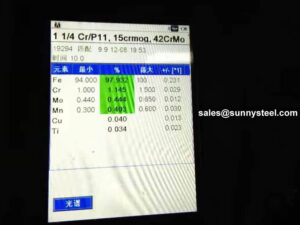
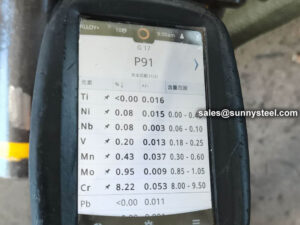
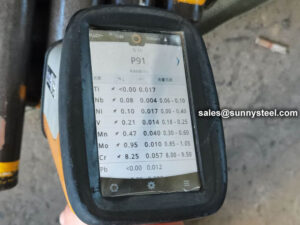
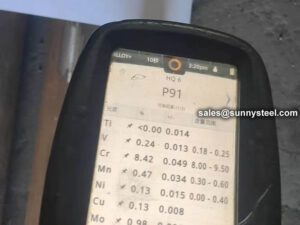
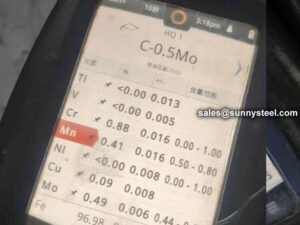
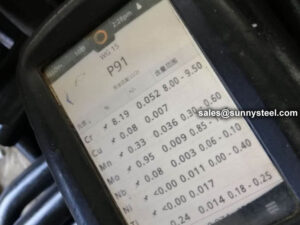
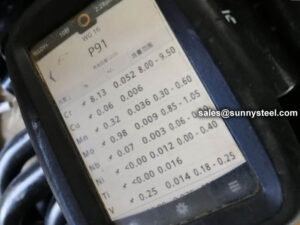
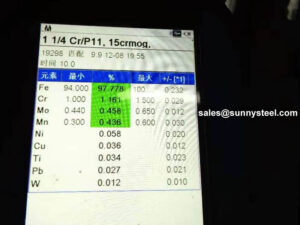
Size measurement
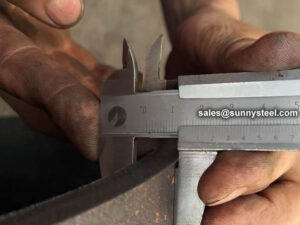
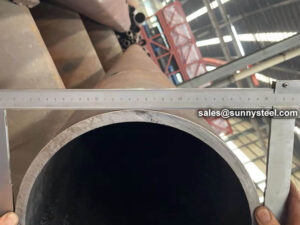
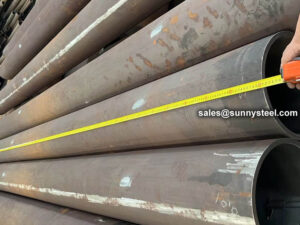
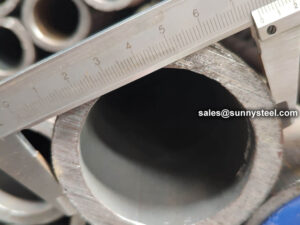
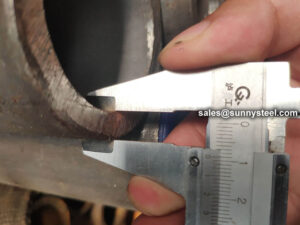
Delivery
Bare packing/bundle packing/crate packing/wooden protection at the both sides of tubes and suitably protected for sea-worthly delivery or as requested.
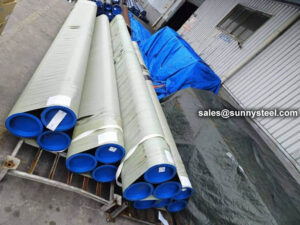
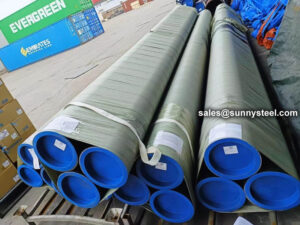
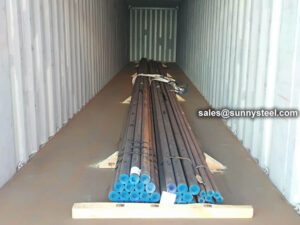
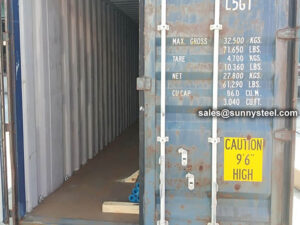
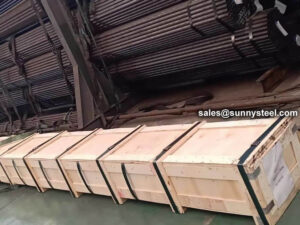
Placing steel pipes into containers
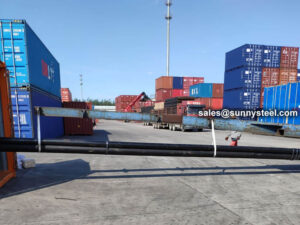
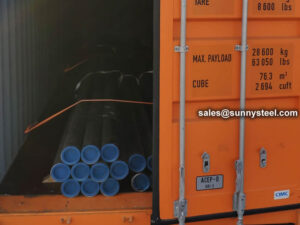
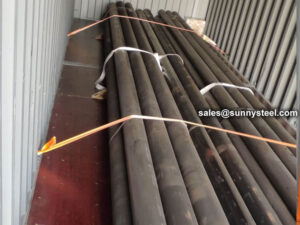
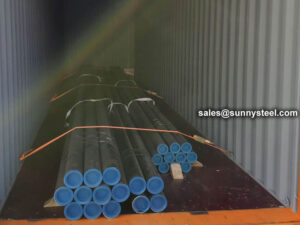
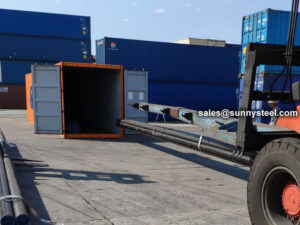
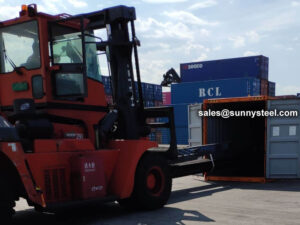

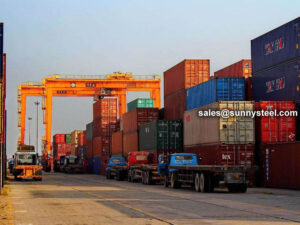
Application
 Alloy steel pipes are ideally suitable for chemical, petrochemicals, and other energy-related applications.
Alloy steel pipes are ideally suitable for chemical, petrochemicals, and other energy-related applications.
The alloy steel pipe adopts high quality carbon steel, alloy structural steel and stainless & heat resisting steel as raw material through hot rolling or cold drawn to be made.
Alloy steel can be used in process area where carbon steel has limitation such as
- High-temperature services such as heater tubes
- Low-temperature services such as cryogenic application
- Very high presser service such as steam header
As an important element of steel products, alloy steel pipe can be divided into seamless steel pipe and welded steel pipe according to the manufacturing technique and tube billet shape.
Here you can see the common alloy steel grade that you will come across.
- For Pipes: ASTM A335 Gr P1, P5, P11, P9
- For Wrought Fittings: ASTM A234 Gr.WP5, WP9, WP11
- For Forged Fittings: ASTM A182 F5, F9, F11 etc.
Why the application of alloy steel pipe is wider than others
There are many kinds of materials used for transport in industrial production. Specifically we will have more choices and it is not limited to the use of alloy steel pipe. But even in the face of more choices, many people tend to choose alloy steel pipe. People make their own choices will have their own reasons. This means the alloy steel pipe application has its own advantages. Compared with transmission lines made of other materials, after it meets the basic application requirements, its quantity is lighter. Then in the practical application of alloy steel pipe, it will have more advantages because of this. Besides its physical characteristic advantage, it also has economic advantages. The wide application of alloy steel pipe is with kinds of reasons. So in practical usage, we can exploit the advantages to the full, in this way can we get more profits in these applications of alloy steel pipe.
What requirements should alloy steel pipe application meet
The transportation of kinds of gases or liquids in production needs to rely on alloy steel pipe. This shows that the actual role of alloy steel pipe application is important. High temperature resistant and low temperature resistant is the tolerance of temperature. In the practical application of alloy steel pipe, there will be many materials need to be transported. However their temperatures are not the same. So this can be the basic requirement to alloy steel pipe. It needs more corrosion resistance. Corrosion resistant material is the best material during transporting, because it is corrosion resistant. So it can be used in more occasions. And it is definitely very convenient for users.
The biggest advantages of alloy steel pipe
Can be 100% recycled, environmentally friendly, energy-saving, resource conservation, national strategy, national policy to encourage the expansion of the field of application of high-pressure alloy pipe. Of alloy steel pipe total consumption accounted steel in the proportion is only half of the developed countries, to expand the field of use of the alloy steel pipe to provide a wider space for the development of the industry. The future needs of the average annual growth of China’s high-pressure alloy steel pipe long products up to 10-12%.
Specification, standard and identification of alloy steel pipes
Alloy Steel pipe contains substantial quantities of elements other than carbon such as nickel, chromium, silicon, manganese, tungsten, molybdenum, vanadium and limited amounts of other commonly accepted elements such as manganese, sulfur, silicon, and phosphorous.
Industries We Serve
Our team of experienced sales specialists proudly partners with gas and chemical processors, power generation plants, oil refineries, and related industries to offer piping components and value-added services.
The biggest advantages of alloy steel pipe can be 100% recycled, environmentally friendly, energy-saving, resource conservation, national strategy, national policy to encourage the expansion of the field of application of high-pressure alloy pipe. Of alloy tube total consumption accounted steel in the proportion is only half of the developed countries, to expand the field of use of the alloy tube to provide a wider space for the development of the industry. According to the Chinese Special Steel Association alloy pipe Branch Expert Group, the future needs of the average annual growth of China’s high-pressure alloy pipe long products up to 10-12%.
Q&A
Our team of experienced sales specialists proudly partners with gas and chemical processors, power generation plants, oil refineries, and related industries to offer piping components and value-added services.
Alloying Elements
| Alloying Elements | Effect on the Properties |
| Chromium | Increases Resistance to corrosion and oxidation. Increases hardenability and wear resistance. Increases high temperature strength. |
| Nickel | Increases hardenability. Improves toughness. Increases impact strength at low temperatures. |
| Molybdenum | Increases hardenability, high temperature hardness, and wear resistance. Enhances the effects of other alloying elements. Eliminate temper brittleness in steels. Increases high temperature strength. |
| Manganese | Increases hardenability. Combines with sulfur to reduce its adverse effects. |
| Vanadium | Increases hardenability, high temperature hardness, and wear resistance. Improves fatigue resistance. |
| Titanium | Strongest carbide former. Added to stainless steel to prevent precipitation of chromium carbide. |
| Silicon | Removes oxygen in steel making. Improves toughness. Increases hardness ability |
| Boron | Increases hardenability. Produces fine grain size. |
| Aluminum | Forms nitride in nitriding steels. Produces fine grain size in casting. Removes oxygen in steel melting. |
| Cobalt | Increases heat and wear resistance. |
| Tungsten | Increases hardness at elevated temperatures. Refines grain size. |
Commonly used alloying elements and their effects are listed in the table given below.
The most important and desired changes in alloy steel are
Alloy steels are made by combining carbon steel with one or several alloying elements, such as manganese, silicon, nickel, titanium, copper, chromium and aluminum. These metals are added to produce specific properties that are not found in regular carbon steel. The elements are added in varying proportions (or combinations) making the material take on different aspects such as increased hardness, increased corrosion resistance, increased strength, improved formability (ductility); the weldability can also change.
- Increased hardenability.
- Increased corrosion resistance.
- Retention of hardness and strength.
- Nearly all alloy steels require heat treatment in order to bring out their best properties.
Alloying Elements & Their Effects
- Chromium – Adds hardness. Increased toughness and wear resistance.
- Cobalt – Used in making cutting tools; improved Hot Hardness (or Red Hardness).
- Manganese – Increases surface hardness. Improves resistance to strain, hammering & shocks.
- Molybdenum – Increases strength. Improves resistance to shock and heat.
- Nickel – Increases strength & toughness. Improves corrosion resistance.
- Tungsten – Adds hardness and improves grain structure. Provides improved heat resistance.
- Vanadium – Increases strength, toughness and shock resistance. Improved corrosion resistance.
- Chromium-Vanadium – Greatly improved tensile strength. It is hard but easy to bend and cut.
Pipes, Tubes and Hollow Sections
Norms:
- API 5L – Line Pipe
- ASTM A 53 – Black and Hot-Dipped, Zinc-Coated, Welded and Seamless, Steel Pipe
- ASTM A 106 – Seamless Carbon Steel Pipe for High-Temperature Service
- ASTM A 213 – Seamless Ferritic and Austenitic Alloy-Steel Boiler, Superheater, and Heat-Exchanger Tubes
- ASTM A 269 – Seamless and Welded Austenitic Stainless Steel Tubing for General Service
- ASTM A 312 – Seamless, Welded, and Heavily Cold Worked Austenitic Stainless Steel Pipes
- ASTM A 333 – Seamless and Welded Steel Pipe for Low-Temperature Service
- ASTM A 335 – Seamless Ferritic Alloy-Steel Pipe for High-Temperature Service
- ASTM A 358 – Electric-Fusion-Welded Austenitic Chromium-Nickel Stainless Steel Pipe for High-Temperature Service and General Applications
- ASTM A 671 – Electric-Fusion-Welded Steel Pipe for Atmospheric and Lower Temperatures
- ASTM A 672 – Electric-Fusion-Welded Steel Pipe for High-Pressure Service at Moderate Temperatures
- ASTM A 790 – Seamless and Welded Ferritic/Austenitic Stainless Steel Pipe
- ASTM A 928 – Ferritic/Austenitic (Duplex) Stainless Steel Pipe Electric Fusion Welded with Addition of Filler Metal
- EN 10208-2 – Steel pipes for pipelines for combustible fluids – Part 2: Pipes of requirement class B
- EN 10210-1/2 – Hot finished structural hollow sections of non-alloy and fine grain steels
- EN 10216-1 – Seamless steel tubes for pressure purposes – Part 1: Non-alloy steel tubes with specified room temperature properties
- EN 10216-2 – Seamless steel tubes for pressure purposes – Part 2: Non-alloy and alloy steel tubes with specified elevated temperature properties
- EN 10217-1 – Welded steel tubes for pressure purposes – Part 1: Non-alloy steel tubes with specified room temperature properties
- EN 10217-2 – Welded steel tubes for pressure purposes – Part 2: Electric welded non-alloy and alloy steel tubes with specified elevated temperature properties
- EN 10219-1/2 – Cold formed welded structural hollow sections of non-alloy and fine grain steels
- EN 10297-1 – Seamless circular steel tubes for mechanical and general engineering purposes – Part 1 Non-alloy and alloy steel tubes
Grade:
- API 5L Gr. A, B, X42, X52, X60, X65, X70
- ASTM A 53 Gr. A, Gr. B
- ASTM A106 Gr. A, B, C
- ASTM A 213 TP 304, 304L, 304H, 316, 316L, 316H, 321, 321H, T5, T9, T11
- ASTM A 269 TP 304, 304L, 304H, 316, 316L, 316H, 321, 321H
- ASTM A 312 TP 304, 304L, 304H, 316, 316L, 316H, 321, 321H
- ASTM A 333 Gr. 3, Gr. 6 ASTM A 335 P1, P2, P5, P9, P11, P12, P22, P91, P92
- ASTM A 358 TP 304, 304L, 304H, 316, 316L, 316H, 321, 321H
- ASTM A 671 CC 60, CC 65, CC 70
- ASTM A 672 CC 60, CC 65, CC 70
- ASTM 790 UNS S31803, UNS S32205, UNS S32750, UNS S32760
- ASTM A928
- EN 10208-2 L245, L 290, L360
- EN 10210-1 S235 JRH, S275 JOH, S275 J2H, S355 JOH, S355 J2H
- EN 10216-1 P235 TR1/2
- EN 10216-2 P235 GH, P265 GH
- EN 10217-1 P235 TR1/2, P275 TR1/2
- EN 10217-2 P235 GH, P265 GH
- EN 10219-1 S235 JRH, S275 JOH, S275 J2H, S355 JOH, S355 J2H
- EN 10297-1 E235, E275, E315, E355, E470
Inquiry
Need to inquire about our products? Fill out the form below and our staff will be in touch!
FAQ
Q: How long is your delivery time?
A: The delivery time of customized products is generally 25 35 days, and non customized products are generally shipped within 24 hours after payment.
Q: Do you provide samples? Is it free?
A: If the value of the sample is low, we will provide it for free, but the freight needs to be paid by the customer. But for some high value samples, we need to charge a fee.
Q: What are your payment terms?
A: T/T 30% as the deposit,The balance payment is paid in full before shipment
Q: What is the packaging and transportation form?
A: Non steaming wooden box and iron frame packaging. Special packaging is available according to customer needs. The transportation is mainly by sea.
Q: What is your minimum order quantity?
A: There is no minimum order quantity requirement. Customized products are tailor made according to the drawings provided by the customer.

 en
en